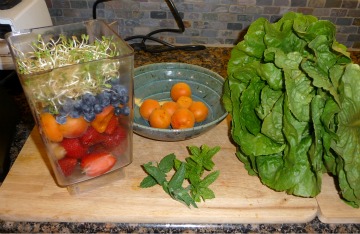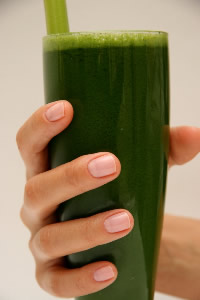
I’ve been thinking of calling my “hurry up vegan” posts “stressed out vegan” instead. This is a hectic time for me, and I’ve been wracking my brains about what to post this week on the blog. I could show you a lot of salads, snack bars, collard wraps, and bowls of overnight oats, but you guys have seen plenty of those already. I could post a dozen smoothies, but how many green smoothies can we all gaze upon before we start to yawn?
Today’s post doesn’t really solve the problem of my culinary redundancy right now, and in fairness, it’s not so very different from a green smoothie. But when I made green juice with avocado yesterday afternoon as a pick-me-up between physics problems, it felt life changing, and I had to immediately share it with you all.
It’s actually sort of shocking that I’ve never thought to make this before. I love green juices, and I love avocado (really, really, really love avocado), so a marriage of the two would seem obvious. That said, I’ve always been a purist about juices: I’ve seen certain juice bars offer to blend green juice with almond milk or with fruit, and to me, that has always seemed like turning juice into smoothie.
The problem with drinking straight up vegetable and fruit juice is that it’s not the most filling snack. In a perfect world. I’d probably drink a green juice every morning upon waking up, do my gym jaunt, and then eat breakfast with coffee after. Or drink a green juice as a snack when I’m not feeling super hungry. But these days, my snacks need to offer me sustenance, and so juice alone isn’t always cutting it. This occurred to me just as I was sending a bunch of greens and pineapple through my Breville juicer yesterday. And, just as quickly, it occurred to me that I had an avocado begging to be used in my fridge.
And the green juice with avocado was born.
I’m sure that I’m not the first juice lover to have thought of this. I’m sure it’s actually fairly commonplace, and indeed, a little Googling suggests that it’s actually on offer at a few juice bars. But to me, this solution to the I-really-want-a-green-juice-but-I-know-I’ll-be-hungry-five-minutes-later problem felt revelatory. And it tasted absolutely fantastic.
I really suggest using the green juice I created for this recipe with the avocado: there’s something about the mixture of pineapple, greens, and avocado that feels like pure magic. That said, you can use your favorite green juice–any mixture at all, really–instead. The important thing is to combine your favorite glass of micronutrient power with the delicious creaminess of fresh avocado; such a perfect beverage for this time of year!
No fancy photos for this post. Just a simple discovery from my kitchen to yours.

Green Juice with Avocado
Serves 2-4 (2 is my own serving size, but I’ve been told I can guzzle more juice than most people!)
1/2 large pineapple, peeled, cored and cut into cubes (about 1 1/2 cups)
1 pear
6 large kale or chard leaves
1 cup broccoli florets
1 heaping handful spinach
1 large cucumber
4 celery stalks
1 inch piece of ginger
1 avocado
Juice all ingredients but the avocado in your juicer. Transfer juice to your blender, and blend with the avocado until totally smooth. Serve immediately.
It may have taken me over six years to discover this incredible drink, but now that I have, it’s the first of many. Cheers!
Speaking of green stuff? I’ve gotten so many messages from you guys saying you love the superfood overnight oats. I’m so glad! I enjoyed a bowl this morning myself, and thought of the readers who might be enjoying them with me. If you come up with any wonderful variations, please let me know!

See you guys back here soon.



 Many
time tested remedies and natural health protocols have been passed
down from generation to generation since the beginning of time. There
are the Ayurvedic traditions from India and the many healing arts from
Asia; in fact every culture has had their own natural formulas and
healing customs. Most of us are familiar with acupuncture, essential
oils, saunas, and massage, all of which come from the past yet play a
very important role in the new health model of today.
Many
time tested remedies and natural health protocols have been passed
down from generation to generation since the beginning of time. There
are the Ayurvedic traditions from India and the many healing arts from
Asia; in fact every culture has had their own natural formulas and
healing customs. Most of us are familiar with acupuncture, essential
oils, saunas, and massage, all of which come from the past yet play a
very important role in the new health model of today.

 We
all love fresh Fruit juice, but vegetable juicing recipes are a bit
brow-raising especially to beginners of the raw foods diet. Fresh
fruits are naturally sweet but most vegetables aren't. Is there a way
to make something healthy taste better than fresh lawn clippings? You
bet there is! Here are some tips for preparing your vegetable juicing
recipes:
We
all love fresh Fruit juice, but vegetable juicing recipes are a bit
brow-raising especially to beginners of the raw foods diet. Fresh
fruits are naturally sweet but most vegetables aren't. Is there a way
to make something healthy taste better than fresh lawn clippings? You
bet there is! Here are some tips for preparing your vegetable juicing
recipes:  4.
Get a good juicer to get the most out of vegetable juicing recipes. You
want to get as much juice from your fruits and vegetables as you can,
while preserving the vitality they contain. Some juicers may produce
better juice, but can be more difficult to clean, so think about what
will work best for you. It’s better to juice every day with a slightly
inferior juicer than once a week with a great juicer. The most
important thing is that any juicer you purchase should have the
capability to juice leafy greens. A juicer that can juice greens along
with fruits and hard vegetables might cost a little more, but juicing
greens is the secret to good health. Hurom makes a vertical slow juicer that is a great value, reliable, and easy to clean. It’s the one I have at home that gets used the most.
4.
Get a good juicer to get the most out of vegetable juicing recipes. You
want to get as much juice from your fruits and vegetables as you can,
while preserving the vitality they contain. Some juicers may produce
better juice, but can be more difficult to clean, so think about what
will work best for you. It’s better to juice every day with a slightly
inferior juicer than once a week with a great juicer. The most
important thing is that any juicer you purchase should have the
capability to juice leafy greens. A juicer that can juice greens along
with fruits and hard vegetables might cost a little more, but juicing
greens is the secret to good health. Hurom makes a vertical slow juicer that is a great value, reliable, and easy to clean. It’s the one I have at home that gets used the most.


